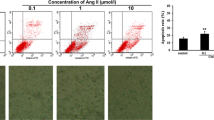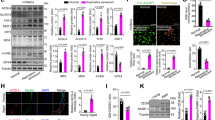Abstract
NADPH oxidase (NOX)-derived reactive oxygen species (ROS) is involved in endothelial dysfunction of hyperlipidemia, and non-muscle myosin regulatory light chain (nmMLC20) is reported to have a transcriptional function in regulation of gene expression. The purposes of this study are to determine whether NOX-derived ROS can promote endothelial progenitor cell (EPC) senescence and whether nmMLC20 can regulate NOX expression through a phosphorylation-dependent manner. The rats were subjected to 8 weeks of high-fat diet feeding to establish a hyperlipidemic model, which showed an increase in plasma lipids and the accelerated senescence and reduced number of circulating EPCs, accompanied by an increase in myosin light chain kinase (MLCK) and NOX activities, p-nmMLC20 level, NOX (NOX2, NOX4) expression, and H2O2 content. Next, EPCs isolated from normal rats were incubated with ox-LDL (100 μg/mL) for 24 h to establish a senescent model in vitro. Consistent with our in vivo findings, ox-LDL treatment increased the senescence of EPCs concomitant with an increase in MLCK and NOX activities, p-nmMLC20 level (in total or nuclear proteins), NOX expression, and H2O2 content; these phenomena were reversed by MLCK inhibitor. NOX inhibitor achieved similar results to that of MLCK inhibitor except that there is no effect on MLCK activity and p-nmMLC20 level. Furthermore, knockdown of nmMLC20, NOX2, or NOX4 led to a down-regulation in NOX and a reduction in ox-LDL-induced EPC senescence. These results suggest that NOX-derived ROS promotes the senescence of circulating EPCs in hyperlipidemia and nmMLC20 may play a transcriptional role in the upregulation of NOX through a phosphorylation-dependent manner.







Similar content being viewed by others
References
Balbarini A, Barsotti MC, Di Stefano R, Leone A, Santoni T (2007) Circulating endothelial progenitor cells characterization, function and relationship with cardiovascular risk factors. Curr Pharm Des 13:1699–1713
Calo LA, Dal Maso L, Pagnin E, Ravarotto V, Facco M, Boscaro E, Maiolino G, Pessina AC, Rossi GP (2014) Effect of olmesartan medoxomil on number and survival of circulating endothelial progenitor cells and calcitonin gene related peptide in hypertensive patients. J Hypertens 32:193–199
Chiang CH, Huang PH, Leu HB, Hsu CY, Wang KF, Chen JW, Lin SJ (2013) Decreased circulating endothelial progenitor cell levels in patients with heart failure with preserved ejection fraction. Cardiology 126:191–201
Custodis F, Baumhakel M, Schlimmer N, List F, Gensch C, Bohm M, Laufs U (2008) Heart rate reduction by ivabradine reduces oxidative stress, improves endothelial function, and prevents atherosclerosis in apolipoprotein E-deficient mice. Circulation 117:2377–2387
Diller GP, Thum T, Wilkins MR, Wharton J (2014) Endothelial progenitor cells in pulmonary arterial hypertension. Trends Cardiovasc Med 20:22–29
Fenyo IM, Florea IC, Raicu M, Manea A (2011) Tyrphostin AG490 reduces NAPDH oxidase activity and expression in the aorta of hypercholesterolemic apolipoprotein E-deficient mice. Vasc Pharmacol 54:100–106
Gerrits L, Overheul GJ, Derks RC, Wieringa B, Hendriks WJ, Wansink DG (2012) Gene duplication and conversion events shaped three homologous, differentially expressed myosin regulatory light chain (MLC2) genes. Eur J Cell Biol 91:629–639
Haddad P, Dussault S, Groleau J, Turgeon J, Maingrette F, Rivard A (2011) Nox2-derived reactive oxygen species contribute to hypercholesterolemia-induced inhibition of neovascularization: effects on endothelial progenitor cells and mature endothelial cells. Atherosclerosis 217:340–349
Hermida N, Balligand JL (2014) Low-density lipoprotein-cholesterol-induced endothelial dysfunction and oxidative stress: the role of statins. Antioxid Redox Signal 20:1216–1237
Huang Q, Qin L, Dai S, Zhang H, Pasula S, Zhou H, Chen H, Min W (2013) AIP1 suppresses atherosclerosis by limiting hyperlipidemia-induced inflammation and vascular endothelial dysfunction. Arterioscler Thromb Vasc Biol 33:795–804
Imanishi T, Hano T, Matsuo Y, Nishio I (2003) Oxidized low-density lipoprotein inhibits vascular endothelial growth factor-induced endothelial progenitor cell differentiation. Clin Exp Pharmacol Physiol 30:665–670
Imanishi T, Hano T, Nishio I (2005) Angiotensin II accelerates endothelial progenitor cell senescence through induction of oxidative stress. J Hypertens 23:97–104
Lai P, Liu Y (2015) Angelica sinensis polysaccharides inhibit endothelial progenitor cell senescence through the reduction of oxidative stress and activation of the Akt/hTERT pathway. Pharm Biol 53:1842–1849
Lee CW, Huang PH, Huang SS, Leu HB, Huang CC, Wu TC, Chen JW, Lin SJ (2011) Decreased circulating endothelial progenitor cell levels and function in essential hypertensive patients with electrocardiographic left ventricular hypertrophy. Hypertens Res 34:999–1003
Li H, Liu Q, Wang N, Xu J (2011) Correlation of different NADPH oxidase homologues with late endothelial progenitor cell senescence induced by angiotensin II: effect of telmisartan. Intern Med 50:1631–1642
Li Y, Alatan G, Ge Z, Liu D (2014) Effects of benazepril on functional activity of endothelial progenitor cells from hypertension patients. Clin Exp Hypertens 36:545–549
Liu YH, Liu Y, Chen JY, Zhou YL, Chen ZJ, Yu DQ, Luo JF, Li HL, He YT, Ye P, Ran P, Guo W, Tan N (2014) LDL cholesterol as a novel risk factor for contrast-induced acute kidney injury in patients undergoing percutaneous coronary intervention. Atherosclerosis 237:453–459
Loffredo L, Martino F, Carnevale R, Pignatelli P, Catasca E, Perri L, Calabrese CM, Palumbo MM, Baratta F, Del Ben M, Angelico F, Violi F (2012) Obesity and hypercholesterolemia are associated with NOX2 generated oxidative stress and arterial dysfunction. J Pediatr 161:1004–1009
Messner B, Bernhard D (2014) Smoking and cardiovascular disease: mechanisms of endothelial dysfunction and early atherogenesis. Arterioscler Thromb Vasc Biol 34:509–515
Oikonomou E, Siasos G, Zaromitidou M, Hatzis G, Mourouzis K, Chrysohoou C, Zisimos K, Mazaris S, Tourikis P, Athanasiou D, Stefanadis C, Papavassiliou AG, Tousoulis D (2015) Atorvastatin treatment improves endothelial function through endothelial progenitor cells mobilization in ischemic heart failure patients. Atherosclerosis 238:159–164
Park YS, Taniguchi N (2008) Acrolein induces inflammatory response underlying endothelial dysfunction: a risk factor for atherosclerosis. Ann N Y Acad Sci 1126:185–189
Peng J, Liu B, Ma QL, Luo XJ (2015) Dysfunctional endothelial progenitor cells in cardiovascular diseases: role of NADPH oxidase. J Cardiovasc Pharmacol 65:80–87
Pompilio G, Capogrossi MC, Pesce M, Alamanni F, DiCampli C, Achilli F, Germani A, Biglioli P (2009) Endothelial progenitor cells and cardiovascular homeostasis: clinical implications. Int J Cardiol 131:156–167
Poss J, Lorenz D, Werner C, Pavlikova V, Gensch C, Speer T, Alessandrini F, Berezowski V, Kuntz M, Mempel M, Endres M, Bohm M, Laufs U (2013) Diesel exhaust particles impair endothelial progenitor cells, compromise endothelial integrity, reduce neoangiogenesis, and increase atherogenesis in mice. Cardiovasc Toxicol 13:290–300
Rossi F, Bertone C, Michelon E, Bianco MJ, Santiemma V (2013) High-density lipoprotein cholesterol affects early endothelial progenitor cell number and endothelial function in obese women. Obesity (Silver Spring) 21:2356–2361
Shen GX (2010) Oxidative stress and diabetic cardiovascular disorders: roles of mitochondria and NADPH oxidase. Can J Physiol Pharmacol 88:241–248
Skrzypkowska M, Mysliwska J, Slominski B, Siebert J, Gutknecht P, Ryba-Stanislawowska M (2015) Quantitative and functional characteristics of endothelial progenitor cells in newly diagnosed hypertensive patients. J Hum Hypertens 29:324–330
Sun C, Wu MH, Yuan SY (2011) Nonmuscle myosin light-chain kinase deficiency attenuates atherosclerosis in apolipoprotein E-deficient mice via reduced endothelial barrier dysfunction and monocyte migration. Circulation 124:48–57
Tabas I, Garcia-Cardena G, Owens GK (2015) Recent insights into the cellular biology of atherosclerosis. J Cell Biol 209:13–22
Vemparala K, Roy A, Bahl VK, Prabhakaran D, Nath N, Sinha S, Nandi P, Pandey RM, Reddy KS, Manhapra A, Lakshmy R (2013) Early accelerated senescence of circulating endothelial progenitor cells in premature coronary artery disease patients in a developing country - a case control study. BMC Cardiovasc Disord 13:104
Zhang H, Davies KJ, Forman HJ (2015a) Oxidative stress response and Nrf2 signaling in aging. Free Radic Biol Med 88:314–336
Zhang HF, Li TB, Liu B, Lou Z, Zhang JJ, Peng JJ, Zhang XJ, Ma QL, Peng J, Luo XJ (2015b) Inhibition of myosin light chain kinase reduces NADPH oxidase-mediated oxidative injury in rat brain following cerebral ischemia/reperfusion. Naunyn Schmiedeberg's Arch Pharmacol 388(9):953–963
Zhang YS, Liu B, Luo XJ, Zhang JJ, Li NS, Ma QL, Jiang JL, Li YJ, Li Q, Peng J (2015c) A novel function of nuclear nonmuscle myosin regulatory light chain in promotion of xanthine oxidase transcription after myocardial ischemia/reperfusion. Free Radic Biol Med 83:115–128
Zhou Z, Peng J, Wang CJ, Li D, Li TT, Hu CP, Chen XP, Li YJ (2010) Accelerated senescence of endothelial progenitor cells in hypertension is related to the reduction of calcitonin gene-related peptide. J Hypertens 28:931–939
Zhu HQ, Wang F, Dong LY, Zhou Q, Wang Y (2014) MicroRNA1 modulates oxLDL-induced hyperlipidemia by down-regulating MLCK and ERK/p38 MAPK pathway. Life Sci 107:21–26
Zhu HQ, Zhou Q, Jiang ZK, Gui SY, Wang Y (2011) Association of aorta intima permeability with myosin light chain kinase expression in hypercholesterolemic rabbits. Mol Cell Biochem 347:209–215
Acknowledgments
This work was supported by the Major Research Plan of the National Natural Science Foundation of China (no.91439104 to Jun Peng), National Natural Science Foundation of China (no.81373409 to Jun Peng, no.81370250 to Qi-Lin Ma), Natural Science Foundation of Hunan Province, China (no.13JJ2008 to Jun Peng), and Doctoral Fund of the Ministry of Education of China (no.20120162110056 to Jun Peng).
Author information
Authors and Affiliations
Corresponding author
Additional information
Ting-Bo Li and Jie-Jie Zhang contributed equally to this work.
Electronic supplementary material
ESM 1
(DOC 1416 kb)
Rights and permissions
About this article
Cite this article
Li, TB., Zhang, JJ., Liu, B. et al. Involvement of NADPH oxidases and non-muscle myosin light chain in senescence of endothelial progenitor cells in hyperlipidemia. Naunyn-Schmiedeberg's Arch Pharmacol 389, 289–302 (2016). https://doi.org/10.1007/s00210-015-1198-y
Received:
Accepted:
Published:
Issue Date:
DOI: https://doi.org/10.1007/s00210-015-1198-y




